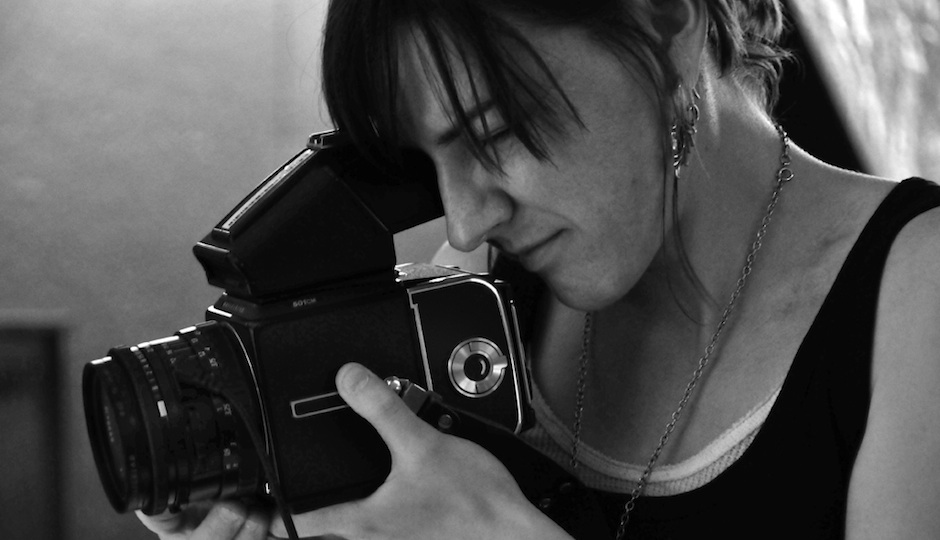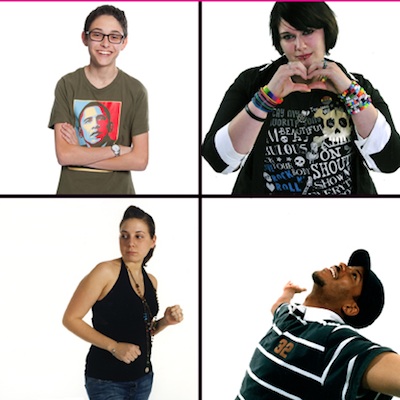Rachelle Lee Smith, Artist Behind Speaking OUT, on Displaying Queer Art on Broad Street

Rachelle Lee Smith
Chances are, you’ve seen Rachelle Lee Smith‘s work: you just haven’t realized it is hers.
If you’ve walked by the now abandoned Robbinson Luggage store on the corner of Broad and Walnut over the last few months, you’ve surely taken note of the plethora of pictures of LGBTQ youth in the windows. This pop-up project, which is part of Smith’s Speaking OUT: Queer Youth in Focus, has brought her photography quite a bit of local attention. The aim of Smith’s photoessay is to, according to her, “open up minds, humanize the people who fall under the LGBTQ (and the list goes on) spectrum, and create empathy.”
The accomplished artist, whose work has appeared in The Advocate and has been featured by the HRC, NPR, and Equality Forum, is teaming up with B. Proud, a fine arts photographer who is an instructor at University of Arts, for a one night only reading and signing at Giovanni’s Room on December 9. We sat down with the talented artist to discuss her work and arts advocacy before her upcoming Philly engagement.
G Philly: Your work is on display on the corner of Broad and Walnut at the vacant Robbinson Luggage store. It seems like that gave you such interesting public exposure. What was that like and how did that project come about?
RLS: I was asked to participate by the University of the Arts, where I have completed most of the pieces for this body of work as they own the space that was once Robbinson Luggage. While it is under contract, they wanted to take advantage of the windows! It was only supposed to be a 3 week pop up installation, and that was 4 months ago! I work around the corner so I have the incredible opportunity to catch people looking at it or talking about it and, when I’m feeling adventurous, I will talk to them. From those brief interactions, I have had people come out to me that are coming out to themselves, and have had a few great discussions. The location is fantastic as it is in between the gayborhood and the highly touristy Center City/City Hall area and serves exactly what I hope to achieve with this work: to have faces and text represent the human experience. It is not until someone reads the handwritten statements do they learn what, if anything, these people have in common. I believe just by viewing the young faces on “display,” people can connect to or relate to themselves or their younger self. This is a perfect location for this!
G Philly: What can attendees expect to see and hear at Giovanni’s Room during your presentation?
RLS: Barbara Proud and I will give a talk about our recently published books. I will discuss a little history around the project, both photographic, historic, and personal history that was the inspiration for the work and will have a slide show along with the talk. I will also have a few of the people that participated in the book speak. Their first hand accounts and personal stories in addition to being able to reflect on what they wrote a decade ago, how they have changed, and how the climate has changed, is really powerful. We will also have a few photos on display!
G Philly: How do you think art can help create a bridge between the lgbtq youth you work with and the general public?
RLS: I think art, in the case of that in Speaking OUT, creates a cathartic experience. It allows for creative expression and a personal

Selections from “Speaking OUT.”
outlet as if exposing a diary entry to the world. Of course, all subjects in my work were asked to write anything they wanted and that did not mean solely addressing their sexuality. However, I believe a lot chose to write about that because they wanted to come out, to free themselves of something and to show the world that they are not ashamed or that they have something valid to share. I think art, in general, is a great means for information sharing and photography s always a terrific tool for story telling. In this case the subjects tell the story instead of letting their environment do so, as photographs often do. Art can be easily taken in and the message absorbed without forcefully pushing an issue. In the case of photographs and short handwritten words I think it is easily digestible, humanizing, and my hopes are that it will create dialogue.
G Philly: We are living in a world where arts funding in public schools is the first to be cut or eliminated. Why are the arts and expression so important for youth?
RLS: Art creates an outlet for creative expression. Whether literal or abstract, youth can use art as a therapeutic means to work out their demons, or the tribulations of being an adolescent, which we all now to be a difficult time! Art allows people to think critically and in ways different than memorization or with a systematic routine. It helps tap into a different part of their thinking and can really be a beneficial tool for releasing repressed, ashamed, or emotions that they otherwise would not let surface. To cut funding for the arts not only hurts the students, but further stifles our contributions to the creative world (architecture, products,technology, in addition to the traditional painting, etc. Heck, one of the guys who created the Mars rover was a University of the Arts grad in sculpture!)
For more information on Ms. Smith’s work, click here. The reading will take place on December 9 at Giovanni’s Room, 345 S. 12th Street, Philadelphia, starting at 6 PM.)


